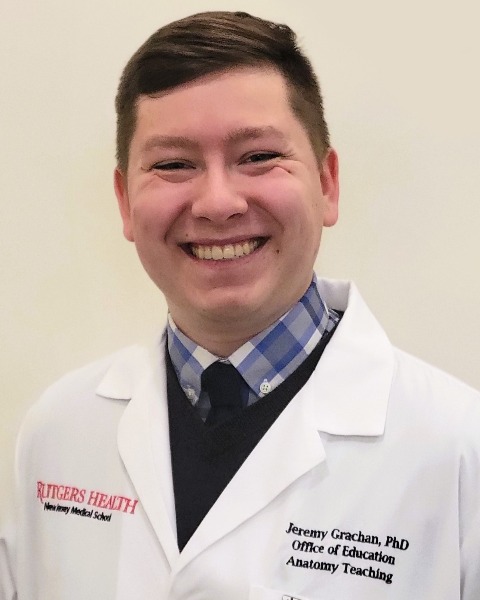Anatomy Education Posters
Poster: Anatomy Education Posters
154 - Components of Donor Memorialization Practices at Religious Institutions in the United States
Sunday, March 24, 2024
5:00pm - 7:00pm US EDT
Location: Sheraton Hall
Poster Board Number: 154
There are separate poster presentation times for odd and even posters.
Odd poster #s – first hour
Even poster #s – second hour
Co-authors:
There are separate poster presentation times for odd and even posters.
Odd poster #s – first hour
Even poster #s – second hour
Co-authors:
Rhiannon robinson - Boston University Chobanian & Avedisian School of Medicine; Julie Doll - University of St. Francis; Kelsey Stevens - Briar Cliff University; Bobbie Leeper - Seton Hill University

Jeremy J. Grachan, Ph.D
Assistant Professor of Medicine
Rutgers New Jersey Medical School
Newark, New Jersey, United States
Presenting Author(s)
Abstract Body : Introduction: Many institutions that utilize human body donors honor the gift through various reflections, art, and services. One aspect that has yet to be actively explored in the literature, especially in the United States, is how religion may play a role in the planning and delivery of the memorialization practices at religious institutions. This study aimed to collect information about human body donor memorialization practices at religious institutions in the United States to help guide further suggestions for enhancing inclusivity in donor memorialization practices.
Methods: This study was open to all programs (e.g., undergraduate, graduate, professional) at religious institutions that utilize human body donors. A Qualtrics survey was distributed through three major modalities: professional society listservs, individual emails, and through personal social media accounts. The study surveyed both religious and non-religious elements of donor memorialization practices. All data was analyzed in Microsoft Excel.
Results: Responses (n = 39) suggest that most religious institutions have some form of donor memorialization practices (n = 31). Of those that hosted donor memorial services, most themes were characterized as interfaith (58.06%), while the others were representative of a single faith/religion (25.81%) or as nondenominational (16.13%). Religious components primarily incorporated prayers from the institution’s denomination (61.29%), a blessing of the donors (58.06%), and religious readings/Psalms (48.39%). Non-religious components regularly included student reflections (90.32%), while other elements were included to a lesser degree such as non-religious music, candles, flowers, poems, and artwork. When asked if the programs hold a formal mass or service, 15 (48.39%) responded “yes” and 16 (51.61%) responded “no”.
Conclusions and Significance: Most religious institutions that utilize and memorialize human body donors take a more inclusive interfaith approach to their memorialization practices. This is more representative of the body donors and students who learn from them. While many of the memorialization practices can be inclusive of differing beliefs, many programs also include prayers and bless the donors, which may not be inclusive of the donors’ beliefs if not conducted in an interfaith fashion.
Methods: This study was open to all programs (e.g., undergraduate, graduate, professional) at religious institutions that utilize human body donors. A Qualtrics survey was distributed through three major modalities: professional society listservs, individual emails, and through personal social media accounts. The study surveyed both religious and non-religious elements of donor memorialization practices. All data was analyzed in Microsoft Excel.
Results: Responses (n = 39) suggest that most religious institutions have some form of donor memorialization practices (n = 31). Of those that hosted donor memorial services, most themes were characterized as interfaith (58.06%), while the others were representative of a single faith/religion (25.81%) or as nondenominational (16.13%). Religious components primarily incorporated prayers from the institution’s denomination (61.29%), a blessing of the donors (58.06%), and religious readings/Psalms (48.39%). Non-religious components regularly included student reflections (90.32%), while other elements were included to a lesser degree such as non-religious music, candles, flowers, poems, and artwork. When asked if the programs hold a formal mass or service, 15 (48.39%) responded “yes” and 16 (51.61%) responded “no”.
Conclusions and Significance: Most religious institutions that utilize and memorialize human body donors take a more inclusive interfaith approach to their memorialization practices. This is more representative of the body donors and students who learn from them. While many of the memorialization practices can be inclusive of differing beliefs, many programs also include prayers and bless the donors, which may not be inclusive of the donors’ beliefs if not conducted in an interfaith fashion.

